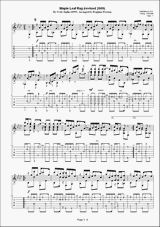Details : Procedure in my way of arranging.
As you see one of my sheets of arrange, with clicking the left image picture for example, I've made them by PC with Notation Software - TablEdit. Although the wonderful soft and tool they are, to finish an arrangement still needs someone's talent, as what's like "one percent inspiration and 99 percent perspiration". However, these new methods may help my perspiration enough, and have brought a kind of "Modern procedure" whole in my music life, I suppose
So, in this sub-chapter I'm going to write about this procedure for finishing the work, while the magic of inspiration might be laid in another sub-chapter, "General". Besides, I could write someday some short essay or document about this theme, in like a Blog style... ;-)
Stages from beginning to end
1. Overview & Hand-made
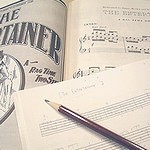
As the very beginning, we need to overview the original score to judge if the guitar arrange will be possible or not. If possible, I just start and write it down by hand to the blank tab sheet which is also hand-made of staff notation sheet by another one line added for myself, of course for making guitar tab sheet. And the detailed process are listed below...
- Tuning and use of Capo is determined. Some typical pattern are; (Original) A-flat = (Guitar) Dropped G with Capo on 1st, D & G = Dropped D, etc. Some unique tunings are taken for playing easiness.
- Where have the priorities of overview will be; The highest & lowest phrase of melody, the very 1st phrase in the 1st section and the 3rd secction, which usually includes some modulation, and whole complexity, etc.
- Using the notation soft nowadays have made my hand-writing more simply or messy, just like a memo.
2. Input data into the software
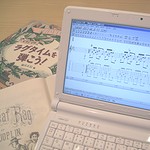
As the first rough transcription is finished, I put it into the software - "TablEdit"(TE). Nowadays I do this procedure earlier than ever, for example, as soon as one section is finished, because of the utilities of the software; Beautiful to see and possible to check with the sound (of Midi play). In this early stage, to play whole notes smoothly on the real guitar is really hard & difficult - especially in Ragtime, however, with the notation software we can listen and review it as if the sound and/or the transcription is proper and comfortable.
- First I put the basic data into TE, like the tuning, the use of capo, both the key & time signatures, and the Midi data like the playing tempo & sound, etc. In fact I usually re-use an older sheet to new one with coordinating them. This can be done easily, thanks to the similarity of music form in Ragtime - useful music keys with some flats, time signature on 2/4, usually in march tempo, and so on.
- Second the notes (the number of fret on each string to play) on the tab are put into the blanked tab sheet on the screen, so that the musical notation is created AUTOMATICALLY - it's great! Of course we need some coordination, but it's not so hard to do, if you get used to it ;-)
- Repeated and finished this procedures, I listen the whole section to review for correct. There may be often found mistakes about writing, inputting, and basic misreading of the original score, etc.
3. Examine by the view of player
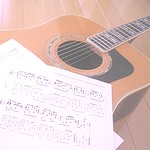
Having finished all data input, it should be printed out for your first review. The format of printing is almost fixed in my case, so I easily proceed in the next stage; Check from the view of players. While I have arranged through the real guitar from the beginning, there may some space to be change - flaws or possibilities. Both could be appeared with various interfaces, so I list them up below also as sub-stages of procedure.
- I play simply from the tab score at first, just like someone who first gets the music sheet. Indeed I can HARDLY play it even if I myself have arranged - this means "The difference between TO PLAY and TO ARRANGE".
- Although I had listened the midi sound before printing, there are various flaws in the score, like the error of input, misreading about the original score in tone, rhythm, and so on. Noticed them with play, I of course correct as they should be.
- Besides, there are lots of parts where I feel difficulties to play - especially at a constant speed and in continuous playing forms. Finding another forms, fingerings and pickings easier, I play and remake many times until I finally feel that there might NO SPACE to correct at that time.
4. Final check & Finish
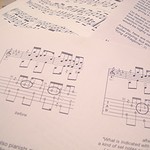
Of course I arrange them to play... however, also feel that it will be a kind of independent work from my performance, as if it might be an artistic picture. So I finally check the output comparing to the oiginal piano score before finisihg all pocesses of my arranging.
- Final checking and comparing to the original piano sheet, mainly paying attention to the expressions in notation, like those between "Double flat" and "Natural", flag direction of notes, etc.
- While being played for my personal fun and joy of ragtime guitar, the work would be supposed if it had a place to change for "KAIZEN" almost forever. Especially, they will be often reviewed and revised again, after a while or before I try on video recording them for YouTube... ;-)
